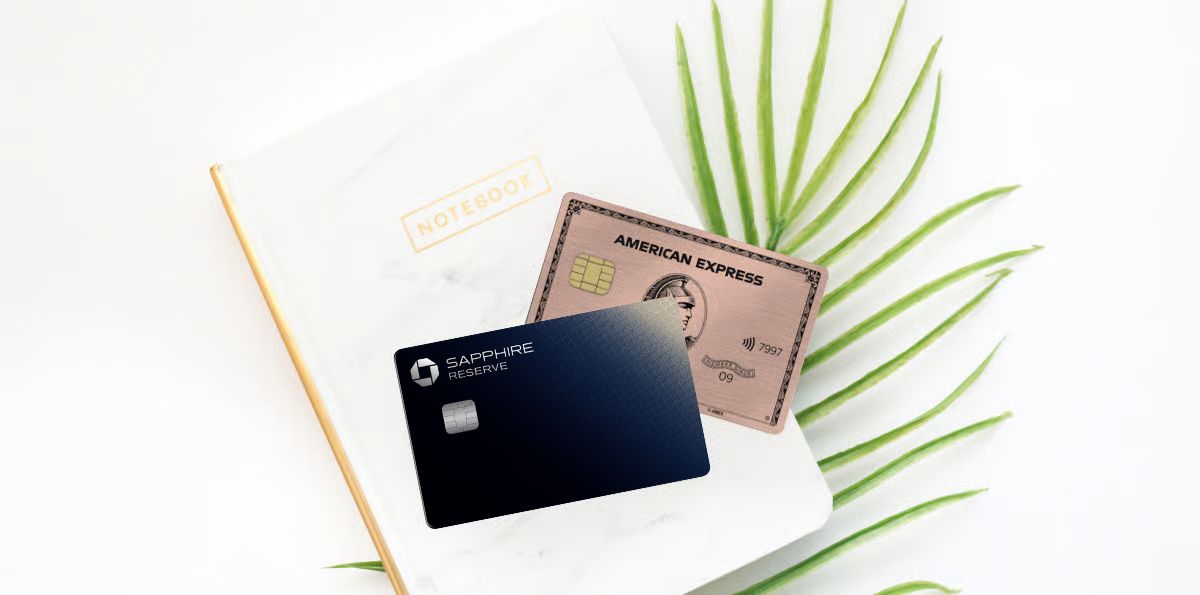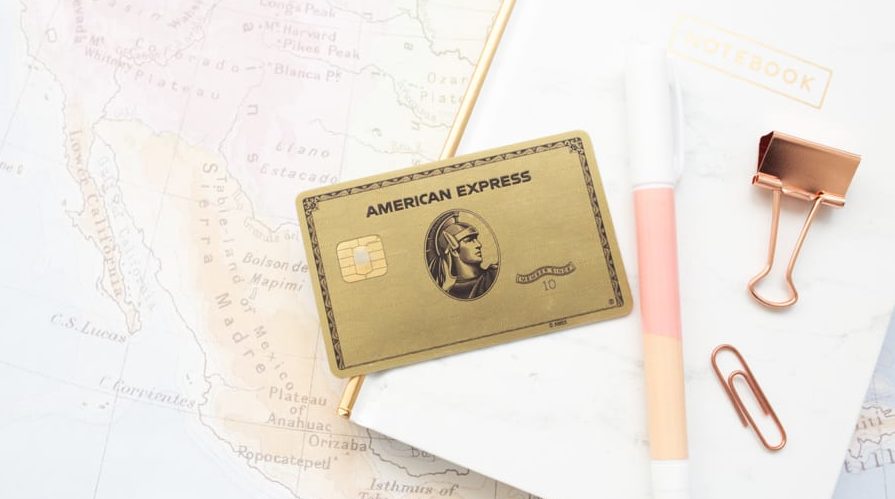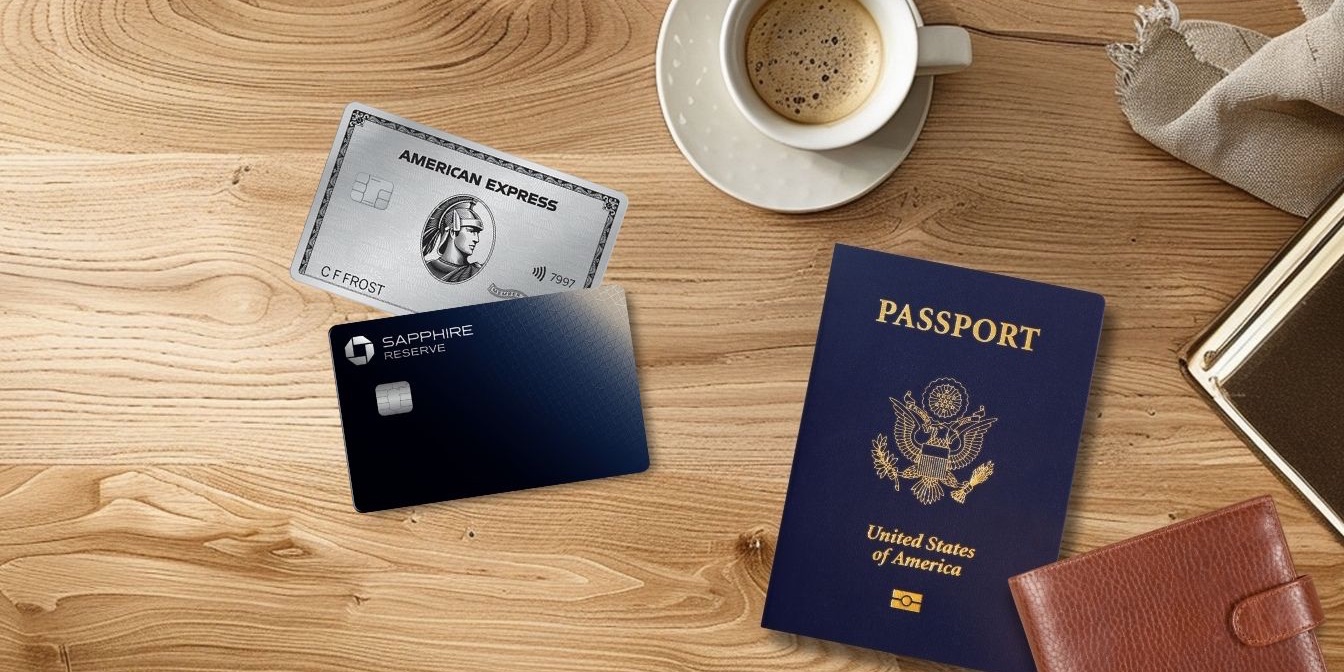Chase and American Express are titans in the world of travel credit cards. And among the many options to unlock travel perks and pile up points are the *amex gold card* and the *chase sapphire reserve*.
The Amex Gold Card is really a mid-tier card: It's not the highest annual fee card in Amex's portfolio nor the lowest. And while it's billed as a travel card, it doesn't come with nearly the amount travel perks you'll get with Amex's top-tier *amex platinum*.
Meanwhile, the Chase Sapphire Reserve reigns supreme as Chase's top travel card. And after a recent refresh, it comes packed with even more perks, travel credits … and a much bigger price tag.
So let's put these two travel cards head to head to see how they differ, and how they're alike, to help you decide which one is best for you.
Welcome Offers
With the *amex gold card*, you can currently earn a big welcome offer: bonus_miles_full
Here's what's at stake with the *chase sapphire reserve*: bonus_miles_full
Read our guide to some of the absolute best Chase redemptions!
Winner: Chase Sapphire Reserve®
Sometimes bigger really is better … and in this case, the Chase Sapphire Reserve undoubtedly comes with a bigger bonus offer.
Learn more about the *chase sapphire reserve*.
Annual Fee
The annual fee on the American Express Gold card is $325 (see rates & fees). We've crunched the numbers and come to the conclusion it can easily be worth that annual fee, but it's still a relatively large upfront cost.
Meanwhile, the Chase Sapphire Reserve now carries a much steeper $795 annual fee, making it the most expensive card on the market. Even with a laundry list of statement credits (more on that in a bit), that's a tough pill to swallow.
Winner: American Express® Gold Card
Neither card is cheap, yet it's fairly easy to do the math and come out ahead with either card when you take all their benefits into consideration. Still, there's no question that the Amex Gold card wins this category with a much lower upfront cost.
Learn more about the *amex gold*
Earning Points
The Amex Gold Card earns 4x Membership Rewards points per dollar spent at restaurants worldwide (up to $50,000 spent each year, then 1x) and 4x Membership Rewards points per dollar spent at U.S. supermarkets (on up to $25,000 of spending annually, then 1x).
Additionally, the Amex Gold card will earn 3x Membership Rewards points per dollar spent on flights booked directly with the airline or through American Express Travel® and 2x points on prepaid hotel and other eligible travel purchases through American Express Travel®. You'll earn 1x point per dollar spent on other eligible purchases.
Read more: A Full Review of the American Express Gold Card
With really useful bonus categories like dining and groceries, the Amex Gold is an excellent choice for all your day-to-day spending.
Meanwhile, the Chase Sapphire Reserve earns 3x points on dining. Unlike the Amex Gold Card, the Sapphire Reserves bonus on dining is uncapped making it a solid choice if you really spend big in this category.
Additionally, the card earns 4x points on hotels and flights booked directly, making it a solid choice for some of your biggest travel expenses. You can even take it a step further by booking through the Chase Travel℠ portal where you'll earn 8x points on all purchases. Additionally, you'll earn 5x points on Lyft rides (through Sept. 30, 2027) and 1x points on all other eligible purchases.
Winner: American Express® Gold Card
This category could really be a toss-up, depending on what you spend on most – but the Amex Gold's 4x point earning on both dining and at U.S. supermarkets is tough to compete with.
Unless your primary expenses are travel-related, the Amex Gold will yield more points for most people.
Learn more about the *amex gold*
Redeeming Points for Travel
In the world of points and miles, having flexible points like those earned with either the Amex Gold or Chase Sapphire Reserve is more beneficial than being locked into a single airline or hotel partner.
That being said, these two types of points aren't created equally. From differing travel portal redemptions to transfer partners and more … it's more like comparing apples to oranges than apples to apples.
Take a look and you'll see what we mean.
Travel Portals
With the Amex Gold, booking direct with American Express Travel®, each Membership Rewards point is worth 1 cent apiece. That's simple enough.
Make sure to read our post on the best ways to redeem Membership Rewards Points.
But one of the best perks on the Chase Sapphire Reserve is that you can redeem each Ultimate Reward points for additional value through Chase Travel℠. With Chase's new Points Boost offers, you can get up to 2 cents per point when redeeming them for premium air cabin tickets and select hotels, including The Edit by Chase Travel.
Non-Points Boost redemptions are worth a flat 1 cent each – the same as Amex.
Read our guide to some of the absolute best Chase redemptions!
Transfer Partners
While you can book directly through both American Express and Chase's travel portals, transferring points to hotel and airline partners can be a great way to get huge value out of your points.
American Express Membership Rewards can be transferred to nearly 20 different airline or hotel partners.
| Program | Type | Transfer Ratio | Transfer Time |
|---|---|---|---|
| Aer Lingus | Airline | 1:1 | Instant |
| AeroMexico | Airline | 1:1.6 | 3-5 days |
| Air Canada Aeroplan | Airline | 1:1 | Instant |
| Air France/KLM | Airline | 1:1 | Instant |
| ANA | Airline | 1:1 | 1-2 days |
| Avianca | Airline | 1:1 | Instant |
| British Airways | Airline | 1:1 | Instant |
| Cathay Pacific | Airline | 1:1 | Instant |
| Delta | Airline | 1:1 | Instant |
| Emirates | Airline | 1:1 | Instant |
| Etihad | Airline | 1:1 | Instant |
| Iberia | Airline | 1:1 | Up to 24 hours |
| JetBlue | Airline | 1.25:1 | Instant |
| Qantas | Airline | 1:1 | Instant |
| Qatar Airways | Airline | 1:1 | Instant |
| Singapore | Airline | 1:1 | Instant |
| Virgin Atlantic | Airline | 1:1 | Instant |
Similarly, Chase Ultimate Rewards can be transferred to 14 airline and hotel partners.
| Program | Type | Transfer Ratio | Transfer Time |
|---|---|---|---|
| Aer Lingus | Airline | 1:1 | Instant |
| Air Canada Aeroplan | Airline | 1:1 | Instant |
| Air France/KLM | Airline | 1:1 | Instant |
| British Airways | Airline | 1:1 | Instant |
| Iberia Plus | Airline | 1:1 | Instant |
| JetBlue | Airline | 1:1 | Instant |
| Singapore Air | Airline | 1:1 | 12-24 hours |
| Southwest Airlines | Airline | 1:1 | Instant |
| United Airlines | Airline | 1:1 | Instant |
| Virgin Atlantic | Airline | 1:1 | Instant |
| World of Hyatt | Hotel | 1:1 | Instant |
| IHG | Hotel | 1:1 | 1 day |
| Marriott Rewards | Hotel | 1:1 | 2 days |
Winner: Chase Sapphire Reserve®
Deciding which card's points are best for travel will largely be a personal decision and depend on how you travel.
While American Express has more transfer partners at its disposal, including some unique partners like ANA, Delta, and Etihad, the Sapphire Reserve's ace in the hole is its ability to redeem points at a greater rate through Chase Travel.
Given that, the nod has to go to the Sapphire Reserve in this category.
Read more: Amex Points vs Chase Points: Which Are Best?
Learn more about the *chase sapphire reserve*.
Statement Credits
Justifying either card's big annual fee is all about whether the benefits outweigh the cost. And statement credits on both the Amex Gold and Chase Sapphire Reserve go a long way to making the math work.
With the Amex Gold, you'll get a monthly dining credit of up to $10 (up to $120 annually) when you pay with the Gold Card at Five Guys, Grubhub, The Cheesecake Factory, wine.com, and Goldbelly. If you don't use the $10 credit each month, you'll lose it – it won't roll over to the next month.
On top of the $120 dining credit, you'll also get up to a $10 per month (up to $120 annually) in Uber Cash to use on U.S. Uber rides or Uber Eats orders. Just be sure to add your Amex Gold Card to your Uber account. This works similarly to the dining credits: You'll get up to $10 to use each and every month, and you'll lose any remaining balance at the end of the month.
But that's not all, the Amex Gold Card underwent a major refresh last summer and now includes a semi-annual up to $50 statement credit (up to $100 annually) for purchases at U.S. restaurants found on Resy. Finally, you'll get up to $7 per month ($84 per year) in the form of a statement credit for purchases with the coffee chain, Dunkin'.
Add it all up, and that's over $400 in credits for a card that only costs $325 per year. If you're able to get full value out of them, which is easier said than done, it's more than enough to cover the card's annual fee outright.
Read more: Tricks to Use (& Not Lose) Your Amex Statement Credits
Meanwhile, the Chase Sapphire Reserve recently underwent a “refresh” of its own and took a page straight out of Amex's playbook by loading the card up with over $2,700 in annual “value.”
One thing that didn't change is the Sapphire Reserve's annual $300 travel credit – and unlike many of the card's new benefits, this one couldn't be any simpler to use.
All you need to do is make (nearly) any travel purchase, from flights to hotels to rental cars, and even parking fees, and up to $300 in statement credits will kick-in automatically. This credit renews each and every year after you pay your annual fee.
Here's what else was added to the Sapphire Reserve earlier this summer:
- $500 The Edit hotel credit: Get up to $250 in statement credits for prepaid, “The Edit” hotel bookings to use from January to June, and again from July to December, up to $500 per year.
- $300 dining credit: Get up to $150 in statement credits from January through June and again from July through December for a maximum of $300 annually for dining at restaurants that are part of our “Sapphire Reserve Exclusive Tables.”
- $300 StubHub credit: Get up to $150 in statement credits from January through June and again from July through December for a maximum of $300 annually for StubHub and viagogo purchases through Dec. 31, 2027 (activation required).
- $120 Lyft credit: Get up to $10 in monthly Lyft credits (up to $120 per year) to use on rides – plus earn 5x total points on your purchase – through Sept. 30, 2027.
- Complimentary Apple TV+ and Apple Music subscription: Get a complimentary Apple TV+ and Apple Music subscription (through June 22, 2027), an annual value of $250.
- $120 Peloton credit: Get $10 in statement credits per month on eligible Peloton memberships through Dec. 31, 2027 (activation required).
Other credits like up to $300 per year in DoorDash credit (and a complimentary DashPass) stuck around as well. With this perk, Sapphire Reserve cardholders get a $5 per month discount on DoorDash restaurant orders and two monthly coupons of up to $10 off on grocery, convenience, and other non-restaurant orders through Dec. 31, 2027.
Finally, the Sapphire Reserve also offers up to $120 in credit to cover the cost of Global Entry, TSA PreCheck, or Nexus every four years.
Winner: Chase Sapphire Reserve®
While Amex cards have become notorious for their “extreme couponing” statement credits, Chase one-upped them with the Sapphire Reserve's relaunch. In terms of which card offers more “money saving” statement credits, the Sapphire Reserve takes the cake … but I'm not sure that's a good thing.
Learn more about the *chase sapphire reserve*.
Lounge Access
If you're looking to get into airport lounges, the Chase Sapphire Reserve is the card for you. End of discussion.
That's because the American Express Gold Card doesn't comes with any level of airport lounge access.
The Sapphire Reserve, on the other hand, comes with a complimentary Priority Pass Lounge membership. This opens the door for you (and up to two guests) to hang out in 1,300-plus airport lounges all over the world.
Additionally, Sapphire Reserve cardholders will also get access to Chase's new Sapphire Airport Lounges. Chase currently has seven open in Boston (BOS), Hong Kong (HKG), New York City-LaGuardia (LGA), New York City (JFK), Phoenix (PHX), San Diego (SAN), and Philadelphia (PHL) … and more are on the way. These lounges are a big step above your typical Priority Pass space.

Sapphire Reserve cardholders get unlimited complimentary access to Sapphire Lounges. They can also bring up to two guests free of charge. Authorized users on the Reserve get their own access and guests, too.
One small hitch: It's not the Reserve that gets you in, but the Priority Pass membership you get from your Reserve card that gets you access. Just be sure to activate that account, and you should be set.
Read more: Chase is Winning The Airport Lounge Wars … & It’s Not Close
Winner: Chase Sapphire Reserve®
If lounge access is a priority, this should be an easy choice. The complimentary drinks, food, and oasis from the airport gates can easily be worth the additional annual fee you will pay on the Reserve card.
Learn more about the *chase sapphire reserve*.
Travel Protections
This one's a doozy.
Between coverage for lost and delayed baggage, medical insurance, and getting reimbursed if your flight gets delayed, there's a lot to unpack. We've devoted a whole post to breaking down the best credit cards for these different policies. But if we have to declare an outright winner, it's got to be the Chase Sapphire Reserve.
It starts with offering up to $100 a day (for up to five days, covering essential purchases like toiletries and clothing) if your baggage is delayed by six hours or more.
Its trip delay and cancellation coverage are second-to-none, reimbursing you for associated expenses of any delay of six hours or more – so long as you pay for your flight with the card. The Chase Sapphire Reserve also has some great car rental coverage. And it offers some hefty coverage for some injuries during a trip that was paid at least in part with the card – including medical evacuation.
American Express upped the ante in 2020 with the Gold Card and other top cards by adding some trip delay and interruption coverage – long a weak spot for the bank. Unfortunately, it requires roundtrip bookings to be put on the card for this coverage to kick in – a quirk you won't find with the Sapphire Reserve.
Likewise, the Amex Gold card's car rental coverage is secondary, not nearly as good – nor is its lost baggage policy.
Winner: Chase Sapphire Reserve®
If it wasn't clear from the outset, the Chase Sapphire Reserve offers unbeatable travel insurance. Even with some enhancements to the coverage offered by the Amex Gold, it just can't compete with all the insurance offered by Chase.
Learn more about the *chase sapphire reserve*.
Bottom Line
By the numbers, the Chase Sapphire Reserve wins five categories and the American Express Gold Card wins two.
That makes the Sapphire Reserve the winner then … right? Not so fast.
Every traveler can (and should) weigh these categories differently. You should pick the card that checks the most boxes for you. Of course, there's nothing stopping you from holding both cards … so long as you can make the annual fee math work in your favor.
At the end of the day, these cards complement each other well. And diversifying your points and miles balances is always a good idea!
Learn more about the *amex gold*
Learn more about the *chase sapphire reserve*.










Nick, you mention ” it’s NOT the Reserve that gets you in ( Chase Lounge) but the Priority Pass membership you get from your Reserve Card that gets you access”. Is the priority Pass Membership different for the Reserve Card vs. the Preferred Card? I have the Preferred Card with Priority Pass membership but was refused entry to the lounge at LGA. Did I need to present the Priority Pass card to gain entry.
Thanks,
John